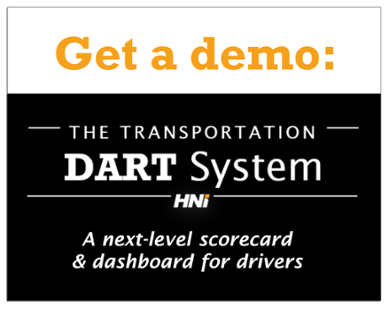Drivers are the heart of the trucking industry – so finding ways to attract them, keep them, and coach them into top performers is essential.
 When looking at how to measure [and improve] driver performance, we use a simple acronym to judge the likelihood of success: DART. We believe that the best systems for activating driver performance are:
When looking at how to measure [and improve] driver performance, we use a simple acronym to judge the likelihood of success: DART. We believe that the best systems for activating driver performance are:
Defined
Aligned
Refined
Timed
In order to accomplish your most audacious goals for the coming year, you’re going to need to usher in an era of meaningful behavior change. Let’s look at how the 4 components of DART can help you drive performance enhancement in your organization.
Part 1: Defined
“Who are our best drivers?” On the surface, it seems like a simple question.
But in nearly every trucking company we’ve ever talked to, it depends on who you ask.
Go to the safety department and ask “who are our best drivers?". Then walk down to operations and ask that very same question. Then ask human resources.
What you’ll likely find is that perspective matters when answering this question. Safety folks gauge a driver's performance against the safety metrics by which they themselves are being evaluated. Operations folks similarly gauge the effectiveness of a driver’s performance against operations metrics.
For the driver, who has to balance these conflicting definitions of performance, clarity on what matters is anything but a reality. How can a driver improve his or her performance without clear a definition of what performance is?
Before you can start improving performance, you need to bring clarity to what matters. Only once we’ve objectively defined what matters will we be able to sit down and have a conversation about who is [and isn’t] performing.
Part 2: Aligned
Once you have objectively defined what performance means within your organization, it’s time to get everyone on the same page about how their performance stacks up.
If you went through the exercise of asking people in your organization who your best and worst drivers were, you witnessed first hand the issue that we are trying to solve here. Misalignment breeds complexity, and complexity prevents us from taking action.
Wouldn’t it be nice if everyone had the same answer to the question “who are our best drivers?”
For drivers, wouldn’t it be nice if they knew exactly where they stood relative to their peers?
When performance goals are aligned across the organization, departments know how their work contributes to the larger whole – and they know how other team members are evaluated. Total alignment requires the safety team to consider the operational demands that a driver faces, and it requires the operations team to consider what it takes to drive safely.
Life (and business) is much easier when everyone is pulling in the same direction.
Part 3: Refined
Everyone wants to be good at what they do. Especially drivers.
But are we actively supporting our drivers’ self-improvement efforts? Are we showing drivers that they’re advancing toward a goal or achieving higher levels of performance?
In a traditional office role, performance recognition comes in the form of new titles or increased responsibility. These signs serve as confirmation that we are in fact improving at what we do, and that we are on the path to becoming an expert in our field.
At most organizations, however, drivers don’t have these kinds of built-in cues to show that they’re successfully advancing their skills.
Building refinement begins with the understanding that we all want to get better. A culture of refinement requires collaboration between drivers, managers, and leadership so that best practices can proliferate throughout your organization.
Part 4: Timed
If you’ve nailed Parts 1-3, you’re almost there. You've defined what performance means in your organization, aligned the team around this new definition of performance, and you’ve committed to continuously refine and improve.
The last step is about timed feedback - a critical requirement in the quest to launch behavior enhancement.
Global consulting juggernaut Accenture recently killed their annual performance review in favor of “a more fluid system, in which employees receive timely feedback from their managers on an ongoing basis ”. This is a great approach – as long as managers and individuals have the tools to view and regularly discuss performance results (and actually take the time to do it).
The right timing may vary based on your culture and management style, but as a rule of thumb, we find that monthly is about right. That’s enough time to get a fair measure of performance and frequent enough to allow for meaningful course corrections.
When drivers know where they stand, they can self-direct their improvement efforts. And if their intrinsic motivation kicks in (as we expect it to), you might not even need to intervene in order to get the behavior change you are looking for.
Timed feedback is about being able to improve your driving behaviors in the current month and reap the benefits of those changes almost immediately.
Where do you stand?
Is performance management at your organization Defined, Aligned, Refined, and Timed? If the answer is “not quite,” you’re not alone.
The Transportation DART System is a performance enhancement system that aims to drive behavior change throughout an organization.
Throw your first DART by signing up for a demo at hni.com/dart.
Related Posts:
The Top 3 Reasons A Driver Scorecard Fails
Legal Landmines in the Trucking Industry: Are You Protected?
Leading vs Lagging Indicators: Using Data to Predict [& Shape] The Future
What Monkeys Can Teach You About Types of Innovation
Change has sent a friend request to all of us…do we ACCEPT or IGNORE?
.png?width=69&height=53&name=Acrisure%20Logo%20(White%20Horizontal).png)


